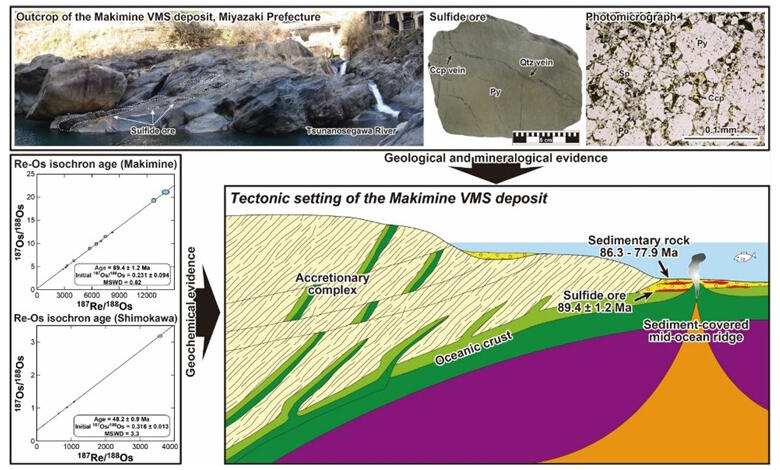A research group including Professor Tatsuo Nozaki of the Faculty of Science and Engineering at Waseda University, Associate Professor Yutaro Takaya of the Faculty of Engineering at the University of Tokyo, Guest Assistant Professor Ken Nakayama of the Marine Core Research Institute at Kochi University, and Director and Principal Research Scientist Yasuhiro Kato of the Ocean Resources Research Center for Next Generation at Chiba Institute of Technology have determined the formation ages of volcanogenic massive sulfides in Nobeoka City, Miyazaki Prefecture, and Shimokawa Town, Hokkaido Prefecture, by the rhenium-osmium (Re-Os) method. The research group revealed that the Makimine deposit in Miyazaki Prefecture and the Shimokawa deposit were formed about 89 and 48 million years ago, respectively. They also succeeded in constraining the timing of the most recent subduction of the mid-ocean ridge (Izanagi-Pacific Ridge) beneath the paleo-Japanese Islands with high certainty based on the formation age values of the deposits. The findings are expected to improve our understanding of the geological history of Hokkaido and the Japanese archipelago, where the geological belts were formed in a complex manner. The study was published in Scientific Reports.

Provided by Waseda University
The basement rocks beneath the Japanese Islands consist mainly of accretionary complexes formed <400 million years ago. During this long history, the mid-ocean ridge is thought to have been subducted beneath the paleo-Japanese Islands multiple times. The subduction of the mid-ocean ridge, which is a heat source, is thought to have caused the formation of the "paired metamorphic belts" and large granitoid plutons (batholiths) that are distributed in the present-day Japanese Islands and the concomitant structural erosion. Thus, ridge subduction is an important geological event to understand geological history.
The timing of the ridge subduction event has been estimated using the ages of microfossils in sedimentary rocks piled up on the basalts originating from the ridge. A limited number of methods have been available to determine the numerical ages with high certainty and precision for various reasons, including deterioration of the preservation conditions of the microfossils due to thermal effects of the ridge subduction event. Accretionary complexes contain ore deposits that were formed on the seafloor in the past, and a wide variety of ore deposits can be observed on the Japanese Islands today. Therefore, they attempted to determine the timing of the ridge subduction event by focusing on Besshi-type deposits associated with in situ basalt.
The Re-Os isochron ages of sulfide minerals at the Makimine deposit in Nobeoka City, Miyazaki Prefecture, which is hosted in the Northern Shimanto Belt, and the Shimokawa deposit in Shimokawa Town, Hokkaido Prefecture, which is hosted in the Hidaka Belt (both deposits are Besshi-type deposits associated with in situ basalts), indicated that the former and latter deposits were formed 89.40±1.20 and 48.20±9.00 million years ago, respectively. The Re-Os isochron ages of the sulfide minerals constituting the ore were similar to the range of microfossil ages of the sedimentary rocks (sandstone and mudstone) in contact with the deposit wallrock; the sulfide minerals had a radiogenic 208Pb-rich lead isotopic composition compared to the wallrock basalt; the sulfide minerals had a higher and broader sulfur isotopic composition compared to the mid-ocean ridge basalt in the Pacific Ocean; and the geothermal gradient estimated from the alteration/metamorphic mineral assemblage in the Makimine area was higher than those in other surrounding areas. These geological and geochemical characteristics revealed that both deposits were formed in a mid-ocean ridge in a shelf sea relatively near the continent supplied with terrigenous sediment (sandstone and mudstone) from the continental crust. Therefore, the Re-Os isochron ages of both deposits may represent the numerical age of the mid-ocean ridge just before its subduction into the geologic belt that formed present-day Miyazaki or Hokkaido Prefecture.
This study showed that the timing of a ridge subduction event could be traced with high certainty using numerical ages by determining the formation age (Re-Os age) of a Besshi-type deposit associated with in situ basalt in accretionary complexes. Such geological and geochemical studies are expected to improve our understanding of the geological history of Hokkaido and the Japanese archipelago, where the geological belts were formed in a complex manner. Moreover, the dating method used in this study may be applied to Besshi-type deposits around the world to improve our understanding of the history of the Earth. Furthermore, determining the timing of these past ridge subduction events will lead to the discovery of new Besshi-type deposits.
Journal Information
Publication: Scientific Reports
Title: Re-Os dating of the Makimine and Shimokawa VMS deposits for new age constraints on ridge subduction beneath Japanese Islands
DOI: 10.1038/s41598-024-80799-z
This article has been translated by JST with permission from The Science News Ltd. (https://sci-news.co.jp/). Unauthorized reproduction of the article and photographs is prohibited.




